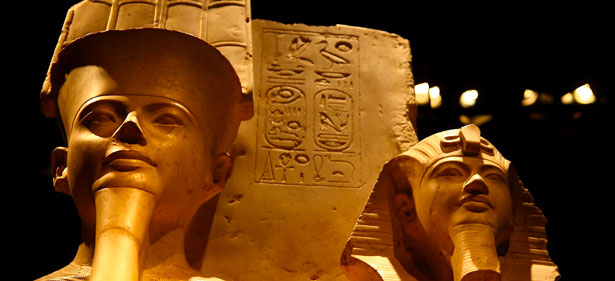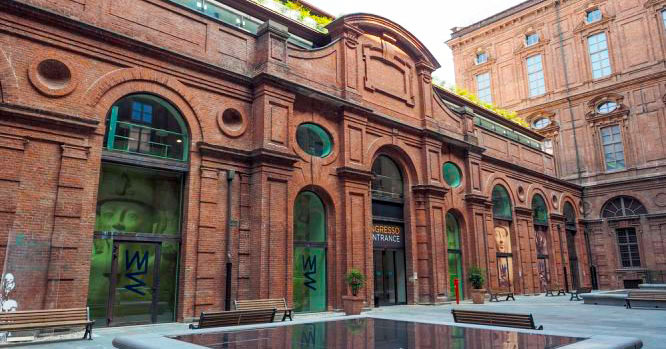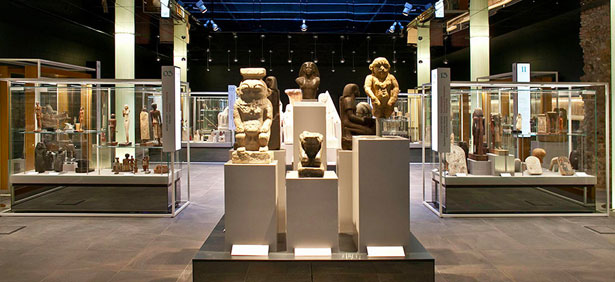Tickets to Egyptian Museum of Turin

Admission tickets to the Egyptian Museum of Turin
By booking your ticket online, you are entitled to visit the Egyptian Museum of Turin at the booked time. This booking includes booked entry to the Egyptian Museum and a digital guide in PDF format of the museum with a personalized map.
The digital guide included in this booking has a vertical view ideal for downloading to the visitor's mobile device and represents a useful tool for organizing the tour inside the museum.
The guide was created by the Italy Travels staff in collaboration with an art historian. Inside the guide you will also find advice for organizing the visit respecting the chronological order of the exhibits on display.
The ticket office is located on the underground floor with the coat check. The ticket is in the form of a bracelet that you are required to wear.
Public hours:
Monday: 9:00 am – 2:00 pm
Tuesday to Sunday: 9:00 am – 6:30 pm
Admission may be booked every 30 minutes.
Last time to book: 12:00 pm, Monday and 4:00 from Tuesday to Sunday (except special openings or closures, or early or late openings some days of the year).
Closed: January 1, May 1, and December 25 (except special openings or closures).
Address: Via Accademia delle Scienze, 6, Turin
TICKET TYPES AND DISCOUNTS
Reduced ticket: For visitors between 15 and 17 and journalists with a valid professional card.
Junior tickets: For visitors between 6 and 14.
Free tickets: Children under 5, disabled persons with a certificate attesting a disability of 74% or higher and their companions, ICOM members, and "Musei Torino Piemonte" and "Torino Piemonte" card holders (these ones directly with the museum institution).
For these ticket types, there is no agency fee, only the €2.00 pre-sale fee required by the museum.
Extra mandatory charges may be applied for current exhibitions, automatically calculated by the system based on the date chosen for the visit.
Teachers: Teachers from any school are admitted with a full adult ticket except when accompanying a school group on an educational tour.
GETTING THERE
Autobus/Tram: lines 13, 15, 55, 56, 72 in Piazza Castello; lines 4, 72 on Via XX Settembre.
From the Porta Nuova Station, walk about 800 m along Via Lagrange-Via Accademia delle Scienze.
From Turin City Airport, Caselle. Bus connection service with Turin's center (Porta Susa and Porta Nuova railway stations); a bus every 30 minutes.
Cancellation Policy. Tickets for this museum are valid for a single admission and once booked, they may not be canceled nor changed for any reason. No refund will be given if they are not used.
Online reservations are limited to a maximum of 9 people per booking.
For groups of 10 or more, please call email us at info@italy-travels.it, noting the group type and if you are interested in a guide service.
Children under 15 must be accompanied by an adult.
SCHOOLS: For private guided tours for schools, please call +39 055 5321180 or write a request to info@italy-travels.it
Egyptian Museum of Turin, History of the Museum

The Egyptian Museum of Turin is famed worldwide as the only museum (other than the one in Cairo) completely dedicated to Ancient Egypt.
Its foundation also predates the Egyptian Museum of Cairo, founded by King Charles Felix of Savoy in 1829 by combining the different collections he had acquired himself and those from collections, such as that of Bernardino Donati, who had gone to Egypt in the mid-18th century and brought many artifacts to Turin.
The museum became an important destination for scholars of Egyptian culture, as well as for the famous explorer Jean-François Champollion, who discovered the Rosetta Stone during Napoleon's campaign in Egypt.
In the late 19th century, Ernesto Schiaparelli, the director of the museum at the time who later became a world-renowned archaeologist, led and organized several excavation campaigns in Egypt to acquire new artifacts. By the early 20th century, it held about 30,000 pieces that showed many aspects of Egyptian culture to the public, including art, architecture, and everyday objects as well as mummies and papyri.
During the previous century, artifacts continued to arrive from the excavations campaigns by the Italian Archaeological Mission from 1900 to 1935. The rule at the time was that discovered artifacts be equally divided between Italy and Egypt. Today, any artifacts found stay on Egyptian soil.
The museum underwent major remodeling in 2015 including reorganization of the rooms, which reopened to the public on April 1, 2015.
The educational areas were expanded and the rooms were equipped with an innovative system of communicating with the public through video guides that give detailed explanations of the museum's exhibits.
The exhibition is organized on four floors (three above ground and one underground) and includes a specialized library as well as areas for restoration and the study of mummies and papyri. This is one of the most visited museums in the world, and visitor numbers have grown by the millions since its re-opening.

UNDERGROUND FLOOR: HISTORY OF THE MUSEUM
After security checks, you'll go into the first floor where you'll hear about the history of the museum from its foundation to the present.
Here you can also see the Iuefankh papyrus, or the famous Book of the Dead, which everyone has heard mentioned in period and adventure movies, like Indiana Jones.
Take an escalator or elevator to the second floor where the tour starts, organized according to the historical periods of ancient Egypt.
SECOND FLOOR: FROM THE PREDYNASTIC PERIOD TO THE NEW KINGDOM
The most important collection is kept on the first floor, from the period of greatest glory in Egyptian history.
These artifacts are from the pre-dynastic period, including the mummy of an adult man dating back to 3500 BC. The deceased is seen in a fetal position in an oval hole with personal items around him. These "pits" were dug into the desert to help dry the body,
evidence that treating the body of the deceased was already important for Egyptian culture in ancient times.
The Gebelein Linen, from the same era, is the oldest painting on linen ever found, discovered in Gebelein, thirty kilometers from Thebes. The fragments have been joined into four panels. This was a very significant discovery because it shows us fragments of daily life at the time, such as dancing, hunting, and sailing.
Another important piece on this floor is the Redit Statue, depicting the Princess Redit who lived at some point between 2592 and 2118 BC. The granodiorite stone was minutely shaped, likely using tools also made of stone. In the Old Kingdom, statues were already essential artistic elements as guardians of Ka, the life force of the deceased.
The museum owns the contents of the Tomb of the Unknown, also from Gebelein, including the mummies and their grave goods,
so-called because the names of the tomb's owners were never discovered. The tomb is interesting because the body's limbs were wrapped separately and the facial features were drawn directly on the mummy.
The same room has material from the Tomb of Ifi and Neferu dating to 2118–1980 BC. This tomb's importance comes from its well-preserved wall paintings of rural themes, arranged with precision on the museum's walls.
Last but not least, the Tomb of Ini, also from Gebelein, belongs to the king's courtier. The importance of this tomb comes from its wooden models and lavish grave goods that became typical of the Middle Kingdom.
The Statue of Uahka, also from the Middle Kingdom, dates to 1850 BC and is a fine example of private sculpture.
From the New Kingdom, the era of Egypt's greatest glory because of great Pharaohs like Ramesses II and Sethi I, we have the Erotic Papyrus, the only example from the Egyptian period of a humorous document featuring anthropomorphized animals.
FIRST FLOOR: FROM THE DEIR EL-MEDINA ARTIFACTS TO THE LATE-ANCIENT ROMAN PERIOD
This floor has artifacts found at Deir El Medina, famed because the mummies of important kings and queens were found in a cave with some of their grave goods.
There are also items from the Ptolemaic and Roman periods, an important Sarcophagi Gallery and a papyrus collection with some of the most important Egyptian papyri.
This floor's star piece is the Tomb of Kha. Found in 1905 near Deir el-Medina, it contained very lavish grave goods including beds, chairs, chests, statuettes, vases, food, and wooden sarcophagi with the mummies of Kha, the chief architect of Pharaoh Amenhotep III, and his wife Merit. When the tomb was discovered, it was intact with every object is the same position where it had been placed 3,400 years before.
Continuing through the floor's rooms, we come into the Sarcophagus Gallery, added in 2015 with the museum's new layout. The gallery has some of the finest sarcophagi of the Third Intermediate and Late Period (1100–600 BC), including the wooden sarcophagi of the royal scribe Butehamon, with one external sarcophagus, an internal one, and a false lid, elaborately decorated on the outside.
GROUND FLOOR: THE GALLERY OF THE KING, THE TEMPLE OF ELLESJJA, AND THE NUBIAN ROOMS
The ground floor, the final section of the Egyptian Museum tour, has the famous Gallery of the Kings.
This spectacular room has many colossal statues, placed with great expertise within the exhibition space. The entrance to the room is guarded by two enormous sandstone sphinxes from 1292–1250 BC. who seem to be there to welcome visitors. Next, we can admire the famous statue of Ramesses II that the French archaeologist Champollion dubbed "the Apollo of the Belvedere of Egyptian art," now the icon of the Egyptian Museum of Turin.
This floor also has the rock temple built by Thutmose III near Abu Simbel in Nubia (present-day Ethiopia): the Temple of Ellesya. Its decorations were sculpted along the walls, first by Akhenaten and then by Ramesses II and lastly by Christians, who added the crosses and five-pointed stars. With the start of construction on the Aswan Dam in 1960, as Lake Nasser was threatening to flood Abu Simbel and other Nubian temples, UNESCO undertook an international mission to recover the temples throughout Nubia. Among the 19 temples that were dismantled and reassembled, one temple was gifted to Italy, whose engineers had helped the rescue operation. This was the Temple of Ellesya, now on the ground floor of the Egyptian Museum in Turin.






